It looks like you're using an Ad Blocker.
Please white-list or disable AboveTopSecret.com in your ad-blocking tool.
Thank you.
Some features of ATS will be disabled while you continue to use an ad-blocker.
share:
reply to post by Mads1987
What about the curve of the window it is looking out? It wouldn't be a flat surface. That could be why it appears to move in almost a straight line rather than arcing slightly.
What about the curve of the window it is looking out? It wouldn't be a flat surface. That could be why it appears to move in almost a straight line rather than arcing slightly.
StephenHannard, i think thats enough to show its either cgi, or a reflection. He is hardly known for his truthfulness now is he
reply to post by homeslice
I don't see 'the shadow' jumping on top of the object at any time, but due to the quality of the video, I am more than willing to call it an artifact either way.
I don't see 'the shadow' jumping on top of the object at any time, but due to the quality of the video, I am more than willing to call it an artifact either way.
reply to post by homeslice
True, I am not sure how or if the curvature of the window would affect it.
True, I am not sure how or if the curvature of the window would affect it.
Neat video.
If it's a lens flare it's a weak lens flare.
If it's a UFO it is impressive in that it can turn from a solid object to a transparent object.
It could be either one of these things, and to call it impressive is kind of a reach. It's just not that great of a video, but it's one of the better ones I've seen on here in awhile! At least it's not an obvious lens flare, or bird of some kind...good to see something that can be debated for a change.
Would have liked to see it react more, rather than watching something going on a jungle cruise or messing with camera equipment. S&F for posting something not painful to look at or think about.
If it's a lens flare it's a weak lens flare.
If it's a UFO it is impressive in that it can turn from a solid object to a transparent object.
It could be either one of these things, and to call it impressive is kind of a reach. It's just not that great of a video, but it's one of the better ones I've seen on here in awhile! At least it's not an obvious lens flare, or bird of some kind...good to see something that can be debated for a change.
Would have liked to see it react more, rather than watching something going on a jungle cruise or messing with camera equipment. S&F for posting something not painful to look at or think about.
Watch it full screen - that dark bit jumps all over the show. Definitely not its shadow.


edit on 31-1-2013 by homeslice because: (no reason given)
reply to post by homeslice
After rewatching a few times, I would agree that the dark part (shadow) seems to be jumping all over the place. In my oppinion it always stays behind the object, but can be seen both on top, underneath it, in fron of it and behind it, as a thin blackish outline.
At this point I am pretty sure it is just artifacts. But a smaaaaall part of me kinda wants to say that it looks a bit like the object has a force field.. But I kinda feel like I am pushing my luck with that statement.
As I stated earlier, if it is anything, I would most likely vote drone or a similar military craft.
After rewatching a few times, I would agree that the dark part (shadow) seems to be jumping all over the place. In my oppinion it always stays behind the object, but can be seen both on top, underneath it, in fron of it and behind it, as a thin blackish outline.
At this point I am pretty sure it is just artifacts. But a smaaaaall part of me kinda wants to say that it looks a bit like the object has a force field.. But I kinda feel like I am pushing my luck with that statement.
As I stated earlier, if it is anything, I would most likely vote drone or a similar military craft.
Lens flares on cockpit window and on the camera lens tend to go (backward) when face and moving toward the sun not (forward).
This is incredible, thanks for posting it S&F.
This is incredible, thanks for posting it S&F.
Originally posted by Mads1987
Not a lense flare
The object seems to be moving very smoothly at the same speed and direction, which it wouldn't do if it was a lenseflare since both the plane and the man holding the camera are in motion. A lens flare would usually accelerate the further it gets from the lightsource in the picture, but that doesn't seem to be the case in the video.
Also, as someone else pointed out, there is a clear shadow cast from the object onto the ground. (Watch in full screen).
As someone else pointed out, its obvious the pilot was holding the camera, it appears to be mounted inside the aircraft, which makes you wonder why they claimed otherwise (maybe nothing sinister, perhaps just an error).
Also the position of the 'object' between the sun and the camera rules out any possibility of the shadow being behind the object in the background. The position of the sun means the object would be backlit, so any shadow would most likely fall below the plane it was being filmed in, and most likely would out of frame of the camera.
Finally, I don't believe a lens flare would accelerate or decelerate across a paning shot - the lens flare should always match the speed of the panning (which it appears to do in this instance as the turn of the aircraft is constant). I'm not an expert in photography and filmography, but a quick search of lens flare examples on YouTube seems to back up my hunch.
The fact that the object moves across the shot in the same motion as a lens flare would (i.e.: it appears and disappears in the shot at the opposite sides to which the light source does) also adds weight to the lens flare possibility. If you watch the shot, you will also notice a halo effect around the object build from the 13 second mark, intensifying until the object is in direct alignment between the camera and the sun, then dimishing until the 17 second mark. This halo is definately a lens flare, and since it grows around the object, would most likely indicate the object is nothing more than a lens flare effect.
Reminds me of a water droplet on the window being pushed by the relative wind against the craft.
Especially the way it catches the sun's rays for a little bit, and orientate towards the sun as the air craft turns, then becomes translucent looking as the sun is no longer directly hitting it.
That and I trust ADG(UK) about as much as I can pick up a mountain and move it. They've been caught hoaxing videos more times that anyone can count. Just go through the HOAX bin here on ATS.
Especially the way it catches the sun's rays for a little bit, and orientate towards the sun as the air craft turns, then becomes translucent looking as the sun is no longer directly hitting it.
That and I trust ADG(UK) about as much as I can pick up a mountain and move it. They've been caught hoaxing videos more times that anyone can count. Just go through the HOAX bin here on ATS.
Originally posted by amkia
Lens flares on cockpit window and on the camera lens tend to go (backward) when face and moving toward the sun not (forward).
This is incredible, thanks for posting it S&F.
This YouTube video unfortunately disproves your case, watch as the lens flare at the start moves in the same direction as the panning of the camera (i.e.: forward with the pan).
Lens flares however will always begin and end at the opposite side to the light source, and since the film matches this behaivour, means a lens flare effect cannot be ruled out.
Not sure what it is but I doubt its a lens flare. Could be fast craft or some kind of light object in the wind. It does appear to be an object and
moving very quickly. Its not connected with the aircraft whatever it is.
Sorry believers, but it is lens flare, or a reflection of the Sun, either way, that is why it Fades out as the plane banks away from the Sun.
Not to mention the pilot only saw the image on the phone screen, when they looked out the windows, the object was not there....Hence, it is a reflection image on the screen only.......Not a real object.
No UFO this time...again.
Not to mention the pilot only saw the image on the phone screen, when they looked out the windows, the object was not there....Hence, it is a reflection image on the screen only.......Not a real object.
No UFO this time...again.
Nice UFO vid. I have seen similar objects.
Lol @ Lens Flare!!!!
Lol @ Lens Flare!!!!
edit on 31/1/2013 by stevcolx because: (no reason given)
The object comes into the frame and exits the frame at the same time as the sun, it's a flare/reflection.
Thats it then. All agree its a lens flare so it must be.
Nevermind. looked not to me but none of us are experts.
Nevermind. looked not to me but none of us are experts.
Originally posted by Arken
In which kind of "Lens Flares World" do you live?
No one expert, with a brief knowledge of photographic skills, can subscribe your opinion.
Definitely lens flare created by the sun reflection on the camera optics...
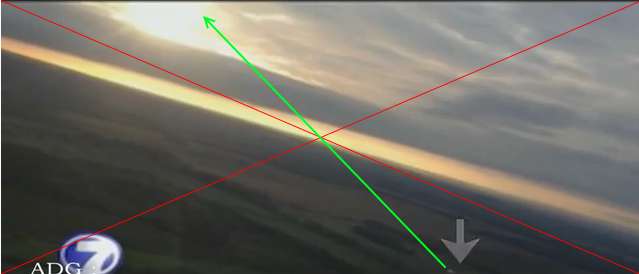
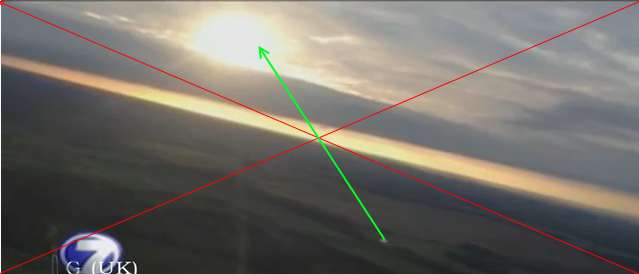
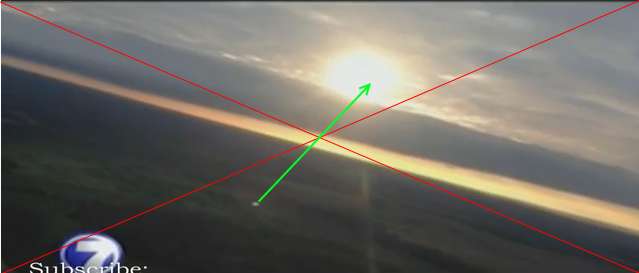
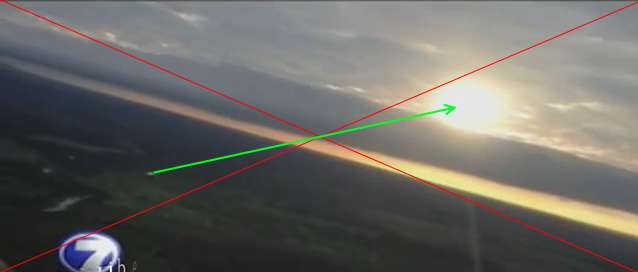
How it works:
The flare is generally due to the presence of a protective filter in the camera, after the lens. It also works however with some lens without this filter.
Anyway, the flare is a mirror ghost of the original bright object (the sun here), with the image center serving as a point of symmetry (or point reflection).
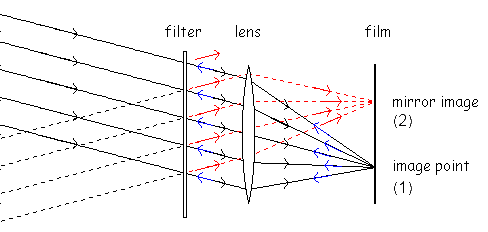
Black arrows indicate the light rays of a distant bright light source that form a regular image point on the film (1). Values for the reflectance of undeveloped photographic film vary from 15% to 40% [see sources 1,2], which makes the film a much stronger reflector than any optical component in the lens.
So, a significant percentage of the light is reflected off the film, partly specular and partly diffuse. (For convenience, we will consider that paths of the reflected light are the same and thus are already drawn for the incident light).
Thus, the blue arrows indicate light reflected from the film. This light encounters the filter, which specularly reflects a small fraction (red arrows). The red rays are parallel and consequently focused onto a point on the film. (2)
The virtual source of the mirror point is traced by the dashed black lines. Note that the blue rays reflected by the film seem odd from the viewpoint of specular reflection; they merely illustrate the fact that all light rays that originate from a single point on the film, and which are collected by the lens, emerge parallel at the filter.
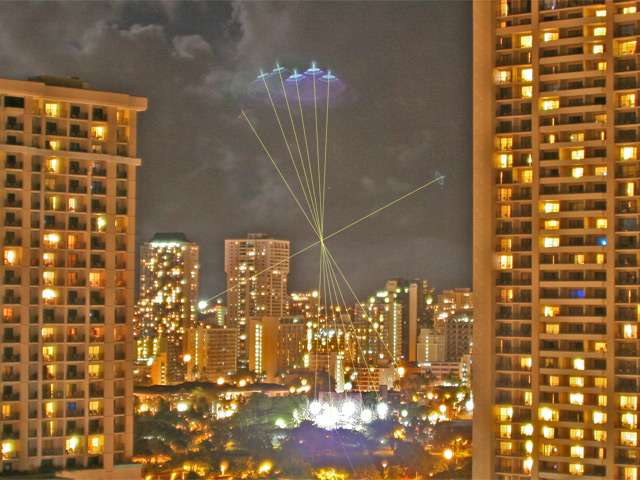
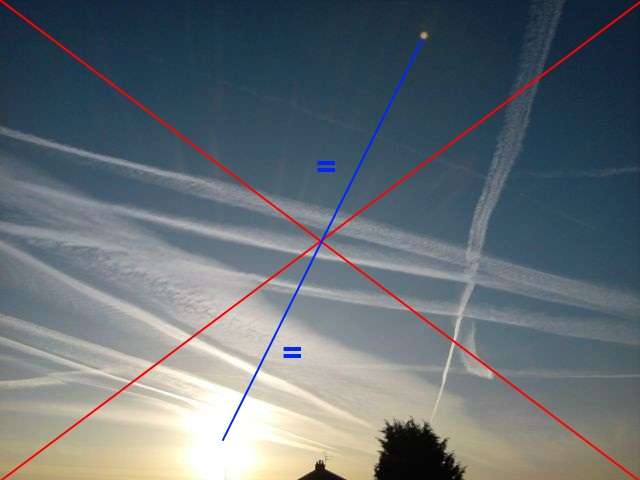
Not all light reflected off the film makes it back to the mirror point. The presence of an aperture stop further reduces the number of rays allowed to return to the film.
The risk of being confronted with filter flare reduces with a smaller focal length, a smaller aperture (larger F-number), an increased separation of highlights from the image center, and with a better filter quality. However, by far the most secure way to avoid this type of flare is to omit the filter altogether.
People who want to try their luck with UFOs may improve their chances by using a tele lens at a large aperture. I guess that, instead of a filter, a lens element with a flat face could also give rise to mirror ghosts.
[1] SPSE handbook of photographic science and engineering, edited by Woodlief Thomas Jr., John Whiley & sons, p. 204 (1973).
[2] Sidney F. Ray, Applied photographic optics, 3rd ed., Focal Press, p. 139 (2002)
edit on 31-1-2013 by elevenaugust because: (no reason
given)
new topics
-
Outgoing Lame Duck BIDEN Officials and Democrats Voice Their Regrets.
2024 Elections: 3 hours ago -
Reflections of Elections past
US Political Madness: 5 hours ago -
President Carter has passed
Mainstream News: 7 hours ago -
Get Reday - Here comes the Bird Flu Pandemic - Millions are Notified
Diseases and Pandemics: 8 hours ago -
2 Guys die hunting Bigfoot
Cryptozoology: 8 hours ago -
Joe Rogan and The Black Keys Diorama
General Entertainment: 10 hours ago
top topics
-
Get Reday - Here comes the Bird Flu Pandemic - Millions are Notified
Diseases and Pandemics: 8 hours ago, 16 flags -
President Carter has passed
Mainstream News: 7 hours ago, 15 flags -
2 Guys die hunting Bigfoot
Cryptozoology: 8 hours ago, 6 flags -
Outgoing Lame Duck BIDEN Officials and Democrats Voice Their Regrets.
2024 Elections: 3 hours ago, 6 flags -
Reflections of Elections past
US Political Madness: 5 hours ago, 5 flags -
Joe Rogan and The Black Keys Diorama
General Entertainment: 10 hours ago, 3 flags
active topics
-
President Carter has passed
Mainstream News • 13 • : WeMustCare -
Joe Rogan and The Black Keys Diorama
General Entertainment • 6 • : GENERAL EYES -
Outgoing Lame Duck BIDEN Officials and Democrats Voice Their Regrets.
2024 Elections • 6 • : WeMustCare -
Treasury Secretary Janet Yellen Says The USA Will Be in Debt Default in Jan 2025 - Unless...
Mainstream News • 35 • : cherokeetroy -
Get Reday - Here comes the Bird Flu Pandemic - Millions are Notified
Diseases and Pandemics • 19 • : DontTreadOnMe -
-@TH3WH17ERABB17- -Q- ---TIME TO SHOW THE WORLD--- -Part- --44--
Dissecting Disinformation • 3846 • : 777Vader -
Why Such An Uproar Over Non-US Citizens With H1-B Work Visas.
Social Issues and Civil Unrest • 79 • : cherokeetroy -
This is why ALL illegals who live in the US must go
Social Issues and Civil Unrest • 35 • : charlyv -
2 Guys die hunting Bigfoot
Cryptozoology • 15 • : Lumenari -
Danish Prime Minister said to keep 3 days worth of canned goods on hand
World War Three • 16 • : Irishhaf
